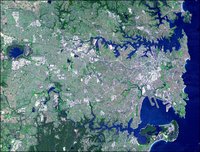Sydney Australia Information
Home > Australian Information > Australian Localities > Sydney
Sydney
From Wikipedia, the free encyclopedia
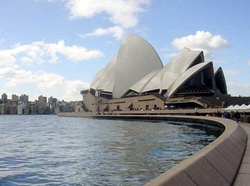
Sydney Opera House
Sydney is the capital city of the Australian state of New South Wales and Australia's largest and oldest city, founded in 1788. With a population exceeding 4 million, the Sydney metropolis is the larger of the two main financial, transport, trade and cultural centres of Australia (the other being Melbourne, Sydney's long term rival to the title of pre-eminent Australian city). Sydney is a significant global and domestic tourist destination and is regularly declared to be one of the most beautiful and livable cities in the world, admired for its harbour, beautiful coastline, warm and pleasant climate and cosmopolitan culture. Sydney significantly raised its global profile in recent years as the host city of the 2000 Summer Olympics. The city's name is pronounced "SID-nee", and a resident of Sydney is popularly known as a "Sydneysider" although the term "Sydneyite" is also sometimes used.
Geography
Sydney is located in a coastal basin between the Pacific Ocean to the east and the Blue Mountains to the west. Sydney features the largest natural harbour in the world, Port Jackson, and also enjoys more than 70 beaches, including the famous Bondi Beach. Sydney's urban area of 1,687 sq km is similar in size to Greater London, but has half that city's population. The metropolitan area (Sydney Statistical Division) has 12,145 sq km, but much of this area is national park and other wilderness.
Sydney can be divided into two geographical regions: the Cumberland Plain, a relatively flat or rolling region lying south and west of the harbour, and the Hornsby Plateau, an elevated (up to 200 m) plateau north of the harbour that is dissected by steep, forested valleys.The Cumberland Plain developed first, and the oldest parts of the city are located in the flat areas. The Hornsby Plateau, known as the North Shore, was slower to develop because of its rough topography, and was mostly a quiet backwater until the Sydney Harbour Bridge was built, linking it to the city south of the harbour. Thereafter the North Shore has become widely upper-middle class suburban in character, although it has developed its own high-rise business districts at Chatswood and North Sydney.
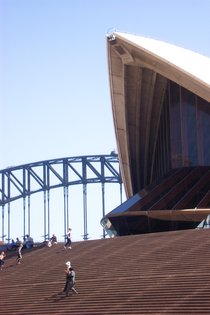
Sails of the Opera House with
Harbour Bridge in background
The central business district (CBD) extends southwards for about 2 km from the point of first European settlement, Sydney Cove. The CBD is an area of very densely concentrated skyscrapers and other buildings, interspersed by several parks such as Wynyard Park and Hyde Park. The CBD is bounded on the east side by a chain of parkland that extends from Hyde Park through The Domain and Royal Botanic Gardens to Farm Cove on Sydney Harbour. The west side is bounded by Darling Harbour, a popular tourist precinct. Central Station marks the southern end of the CBD. George St is the Sydney CBD's main north-south thoroughfare. The streets run on a slightly warped grid pattern in the southern CBD, but in the older northern CBD the streets are less logical, reflecting their random placement in the early days of the city. (See the City of Sydney article for more detail.)
Although the CBD dominated the city's business and cultural life in the early days, significant other business/cultural districts have developed since World War II, in a radial pattern. As a result of business development in other districts, the proportion of white-collar jobs located in the CBD declined from more than 60% at the end of World War II to less than 30% in 2004. The four most significant other business districts are Parramatta in the central-west, Liverpool to the southwest, Chatswood to the north and Hurstville to the south.
Although Sydney does not suffer from cyclones, and the earthquake risk is considered very low, many areas of Sydney bordering bushland have experienced bushfires, including ones in 1994 and 2002. The city is also subject to infrequent severe hail storms and wind storms (maybe once every 5 to 10 years, although these appear to be increasing). In recent years, the city has also faced water shortages. Dam levels are falling to the extent that the state government has imposed a range of prohibitions intended to reduce consumption. The El Niño Southern Oscillation plays an important role in determining weather patterns, with drought and bushfire on the one hand, and storms and flooding on the other being associated with the two opposite phases of the oscillation.
History
The area surrounding Sydney Harbour (called Warrane by the aborigines) has been inhabited by Aboriginal tribes, notably the Eora and Cadigal, for at least 40,000 years. Although urbanisation has destroyed most evidence of these settlements (such as shell middens), there are still rock carvings in several locations. European interest arose with the sighting of Botany Bay (now a southern suburb of Sydney) in 1770 by Captain James Cook. Under instruction from the British government, a convict settlement was founded by Arthur Phillip in 1788. (See the First Fleet article for more information.) Phillip first landed at Botany Bay, but found it unsatisfactorily shallow for a permanent settlement. After a brief sail north, Phillip founded the colony at Sydney Cove on Port Jackson (the correct name for Sydney Harbour).
Phillip originally named the colony "New Albion", but for some uncertain reason the colony acquired the name "Sydney", after the (then) British Home Secretary, Thomas Townshend, Lord Sydney (Viscount Sydney from 1789). This is possibly due to the fact that Lord Sydney issued the charter authorising Phillip to establish a colony. Prisoners were quickly set to work to build the settlement and by 1822 the town had banks, markets, well-established thoroughfares and an organised constabulary; by 1847, convicts accounted for only 3.2 per cent of the population.
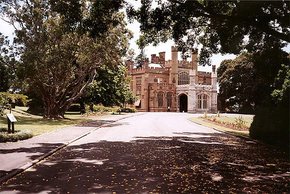
Government House near the Botanic gardens
Each week, ships would arrive from Europe with immigrants looking to start a new life in a new country. The first of several gold rushes was in 1851, since which time the port of Sydney has seen many waves of people from around the world. With industrialisation Sydney expanded rapidly, and by the early 20th century it had a population well in excess of one million. Throughout the 20th century Sydney continued to expand with various new waves of European and (later) Asian immigration, resulting in its highly cosmopolitan atmosphere of the present day.
Historical population
1800: 2,540 inhabitants
1820: 12,000
1851: 39,000
1871: 206,800
1901: 487,900
1925: 1,039,000
2003: 4 million
2050: 6 million (projected)
Timeline of events
1788: First European settlement established
1852: Sydney incorporated as a city
1855: Australia's first railway line linking Sydney with Parramatta
1870: Intercolonial Exhibition (1870)
1879: Sydney International Exhibition (1879)
1883: Parramatta - Intercolonial Juvenile Industrial Exhibition (1883)
1901: Commonwealth of Australia proclaimed in Sydney on January 1
1932: Sydney Harbour Bridge completed
1942: Sydney Harbour attacked by Japanese midget submarines
1973: Sydney Opera House completed
2000: 2000 Summer Olympics
Politics
Sydney has always been a focus for the politics of both State and Federal Parliaments. The electoral boundaries of the local council area (mayoralty) have been significantly altered by state governments on at least four occasions since 1945, with advantageous effect to the governing party in the New South Wales Parliament at the time. Successive State governments of both major parties, the Labor Party and the Liberal Party, have re-drawn the electoral boundaries to include inner suburbs that are traditionally supportive of them, and to exclude suburbs that are traditionally hostile.
A 1987 Liberal re-organisation saw Sydney Council split, with southern suburbs forming a new South Sydney council. This was thought to advantage the Liberal government of the day, as the southern suburbs had traditionally voted Labor.
In 2004, the Labor State Government undid this change, again merging the councils of the City of Sydney and the City of South Sydney. Critics claimed that this was performed with the intention of creating a "super-council" which would be under the control of the Australian Labor Party (ALP), which also controlled the State Government. Subsequent to this merger, an election took place on 27 March 2004 which resulted in the independent candidate Clover Moore taking the position of Lord Mayor from the ALP incumbent. Critics of the merger claimed that this was a result of a voter backlash against the party for attempting to create the "super-council".
Landmarks
The city's most famous landmarks are the Sydney Harbour Bridge and the Sydney Opera House, both of which are located on Sydney Harbour. Sydney's principal river is the Parramatta River, which enters Sydney Harbour from the west. While the Harbour is famous for its racing yachts, the Boxing Day start of the Sydney to Hobart Yacht Race and 18ft skiffs, the river is used for dinghy sailing and rowing as well as recreational boating, racing small yachts, recreational fishing, and occasional Dragon Boat racing. Another famous landmark is the Sydney Tower (also known as Centrepoint Tower or the AMP Tower) which is the second tallest building in the Southern Hemisphere. Darling Harbour is also a popular tourist attraction. Sydney also has an interesting underground railway system (see also CityRail), one of only two in the country (Melbourne has the other). The Sydney Cricket Ground, which retains several beautiful 1920s-era grandstands, hosts several international cricket matches and the Sydney Swans football team. The old adjacent showgrounds, for many years home to the Sydney Royal Easter Show, have been redeveloped as 20th Century Fox's large Sydney studios. Sydney Olympic Park, after holding a large proportion of the major events in the 2000 Olympic Games, now regularly hosts sporting and cultural events, especially at Telstra Stadium. Sydney is also known for the annual Sydney Gay and Lesbian Mardi Gras.
Sydney is home to the Australian Stock Exchange and the Reserve Bank of Australia. It also has 6 universities: the University of Sydney, the University of New South Wales, Macquarie University, the University of Technology, Sydney, the University of Western Sydney, and two of the campuses of the Australian Catholic University.
Tourist attractions
Sydney is noted for its tourist attractions, including:
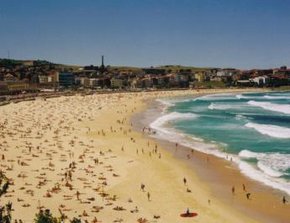
Bondi beach
Bondi Beach
Darling Harbour
Chinatown, Sydney
King Street Wharf
Oceanworld, Manly.
Powerhouse Museum - a museum of science and technology
Sydney Aquarium - Darling Harbour
Sydney Harbour, more correctly known as Port Jackson
Sydney Tower - aka Centrepoint Tower or AMP Tower
Taronga Zoo - Mosman
The Rocks
Culture
Sydney boasts a full roster of musical, theatrical and artistic activity throughout the year, from the formal - including the Sydney Symphony Orchestra, the Sydney Theatre Company, the Sydney Dance Company, and the Archibald Prize - to festivals, including the Sydney Festival, a celebration of free performances throughout January. Many internationally known Australian rock bands have had their conception in Sydney, from Midnight Oil to INXS.
Sydney also has been home to many visual artists, from the lush pastoralism of Lloyd Rees's depictions of Sydney Harbour to Jeffrey Smart's portraits of bleak urban alienation. Sydney has four large and many smaller museums. The biggest are the Australian Museum (natural history and anthropology), Powerhouse Museum (science, technology and design), Art Gallery of New South Wales and the Museum of Contemporary Art.
Sydney is also home to several large ethnic communities throughout the greater metropolitan area, and a significant gay community who host the Sydney Gay and Lesbian Mardi Gras along Oxford Street. To encourage sharing of cultural, trade and tourist links, the City of Sydney Council maintains sister city relations with the cities San Francisco, Nagoya, Wellington, Portsmouth, Guangzhou, and Florence.
Sport
9 teams in the National Rugby League
Sydney Swans - Australian Football League
2 teams in the National Basketball League
4 teams in the National Soccer League
Transport
Sydney is served by extensive train, bus and ferry networks. Sydney trains are run by CityRail, a corporation of the New South Wales State Government. Trains run as suburban commuter rail services in the outer suburbs, then converge in a frequent metro-like service in tunnels under the central business district (CBD). Buses serve the whole metropolitan area. In the city and inner suburbs the state-owned Sydney Buses has a monopoly. Services are frequent, even outside peak hours. In the outer suburbs, service is divided up between many private bus companies. These bus services are often criticised for their relative scarcity of service and sometimes complete lack of off-peak service. Sydney Ferries, another state government-owned organisation, runs extensive commuter and tourist ferry services on Sydney Harbour and the Parramatta River.
Sydney has one light rail line, the Metro Light Rail, running from Central Station to Lilyfield. There is also a monorail which runs in a loop around the main shopping district and Darling Harbour.
Sydney is serviced by an extensive network of motorways and roads. The most important trunk routes in the metropolitan area form the Metroad system.
Kingsford Smith International Airport, located in the suburb of Mascot, is Sydney's main airport. The smaller Bankstown Airport serves mainly commuter and private aviation. There are light aviation airfields at Hoxton Park and Camden. RAAF Base Richmond lies to the north-west of the city.
Regions and suburbs
Regions of Sydney
The extensive area covered by metropolitan Sydney is formally divided into more than 300 suburbs (for addressing and postal purposes), and formally administered by about 38 separate local government areas (in addition to the extensive responsibilities of the New South Wales State government and its agencies). In addition, there are a number of regional descriptions which are used informally to conveniently describe large sections of the metropolitan area. However it should be noted that there are many suburbs which are not conveniently described by any of the following informal regional categories.
Eastern Suburbs
Hills District
Inner West
Northern Beaches
North Shore
Southern Sydney
South-western Sydney
Sutherland Shire
Western Sydney
Sydney suburbs and satellite cities
Metropolitan Sydney cover about 2000 square kilometers, has 4 million inhabitants and about 300 suburbs. There are about 38 local government areas in the Sydney region, each containing several suburbs. See Local Government Areas of New South Wales. The City of Sydney covers a fairly small area comprising downtown Sydney and neighbouring inner-city neighbourhoods.
Local Government Areas
The City of Sydney, as well as:
Ashfield
Auburn
Bankstown
Baulkham Hills
Blacktown
Burwood
Camden
Campbelltown
Canada Bay
Canterbury
Fairfield
Hawkesbury
Holroyd
Hornsby
Hunter's Hill
Hurstville
Kogarah
Ku-ring-gai
Lane Cove
Leichhardt
Liverpool
Manly
Marrickville
Mosman
North Sydney
Parramatta
Penrith
Pittwater
Randwick
Rockdale
Ryde
Strathfield
Sutherland
Warringah
Waverley
Willoughby
Woollahra
This is a partial list of Sydney suburbs and satellite cities.
Selected suburbs
Cambramatta
Castle Hill
Darlinghurst
Glebe
Hornsby
Hurstville
Newtown
Parramatta
Redfern
Sydney localities
Goat Island
Kings Cross
Voyager Point
Rookwood Cemetery
Chinatown, Sydney



